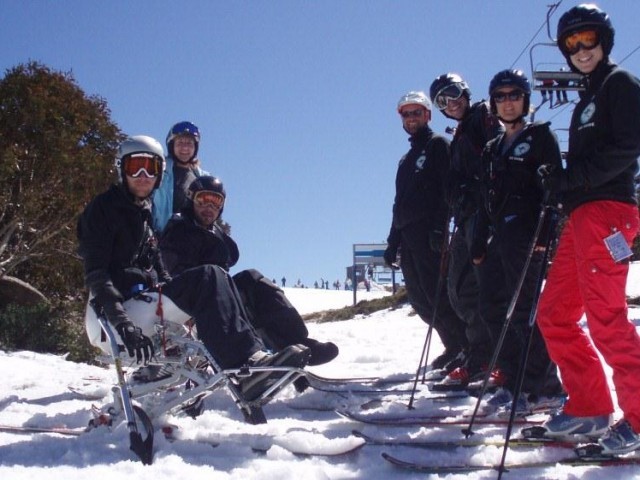Adaptive Snow Sports use adapting equipment and lessons to allow people with disability to experience snow sports. Here's your guide to adaptive snow sports.
Image sourced from Adaptive Skiing
Adaptive Winter Sports Options
Adaptive Snow Sports use adapting equipment and lessons to allow people with disability to experience snow sports.
There are four main disciplines:
- Alpine Skiing – specialist equipment is needed to participate in alpine skiing. It is one of the most challenging and exciting sports there is. Blind skiers can race with a guide. The skiers follow in the tracks of the guides.
- Sit Skiing – Mono-skiing or sit skiing works by attaching a seat to a wide, single ski. Ski poles are also altered by shortening them to allow balance and for steering. Special training is required to use the ski
- Adaptive Snowboarding – adaptive snowboarding allows partially disabled people to participate in the sport. Above the knee amputees can ride with rigging on their prosthetic. People with partial paralysis can use restrictive knee braces and outriggers and paraplegics ride on equipment like a mono-ski
- Cross Country Skiing – cross country, or Nordic skiing, unlike its downhill equivalent, is accessible to far more participants. Cross country skis are deeply groomed, thinner tracks that run parallel to each other. It can allow a more leisurely pace and be more recreational.
Adaptive Equipment
Specialised adaptive equipment allows people with disability to maximise their mobility.
The following are examples of adaptive equipment:
- Outriggers - Outriggers are adapted crutches with a small ski tip attached to the base which can be flipped up to use as a crutch in the lift lines or down in the ski position to assist with balance and initiation of turns. You use outriggers if you are standing skiing. A shorter model is used if you are sit skiing
- 4-track - 4-track skiing is when you do standing skiing but you usually require the assistance of crutches or a walking frame to assist with balance. You may also require the use of a "ski bra" or a "bungee cord" to keep the two skis together. 4-track skiing may be suitable for people with cerebral palsy, multiple sclerosis, muscular dystrophy, post-polio or spina bifida.
- 3-track - 3-track skiing is when you do standing skiing where you ski on one leg with stand up outriggers. This may be suitable for people with a leg amputation or post-polio.
- In sit skiing, there is a bi-ski where the bucket of the sit ski is attached to two skis and a mono ski, where the bucket is attached to one ski. The mono-ski is designed for more advanced skiing.
- For visually impaired skiers, there are various pieces of equipment, including plastic poles. In addition, you may require an instructor who has different communication techniques to guide you down the slope.
- The sno-wing provides an instructor maximum guidance and control of you whilst snowboarding
Did you know?
Did you know that Disabled Wintersport Australia offer an adaptive sports program at the five ski resorts within Australia.
This allows you to access support to:
- Request to book specific adaptive snowsports equipment out of the DWA pool
- Request a volunteer adaptive snowsports guide to assist on snow
- Assistance to book an adaptive lesson through a snowsports school
- Advice on accessible places to stay and how to get around the resort
Looking for more information on how you can participate in adaptive snow sports? Contact IDEAS or call 1800 029 904.
Information sourced from Disabled Winter Sport, In the Snow.com, Adaptive Sports USA


